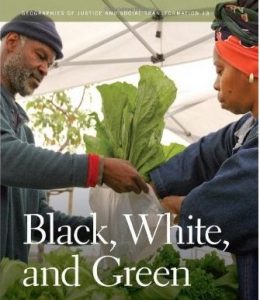 Alison Hope Alkon, Black, White and Green: Farmers Markets, Race and the Green Economy. University of Georgia Press.
Alison Hope Alkon, Black, White and Green: Farmers Markets, Race and the Green Economy. University of Georgia Press.
This book is among many now appearing on how to move to a green economy. The examples are based in the United States but are still pertinent to the situation in Australia.
For Australian publications on this topic I recommend Jane Gleeson-White’s two books, (2011) and its sequel, (2014), Six Capitals: The Revolution Capitalism Has to Have – or Can Accountants Save the Planet?Quote 1
“The green economy is a set of relations and practices in which the production and consumption of goods becomes a strategy toward environmental and social change. Essentially, the growth of specific segments of the economy such as organic food or clean energy, becomes the solution to social and environmental problems.” (p. 9)Quote 2
“The commodification of land and labor requires that human beings and nature become subsumed by the market economy. That neither will be valued beyond their fictive economic worth ensures that both will be destroyed. Through countermovements, people will resist the destruction of nature and society by the market economy.” (p. 33)Quote 3
“Economic sociologists have long argued that economic decisions are not the result of rational cost-benefit analyses, but constructed social worlds that can be infused with individual and collective identities and moral worldviews, including social movement goals. With the green economy, social movement goals also become economic imperatives.” (p. 32)Quote 4
“Farmers markets may be the fastest-growing part of the food economy, but they do little to stop companies like Mansanto from patenting GMO seeds … In other words, creating positive alternatives is not the same as preventing pollution and inequality.” (p.150)

![Call of the Dakini | A Memoir of a Life Lived [Extract]](https://regenesis.org.au/wp-content/uploads/2023/08/Catalogue-OF-Articles-by-Barbara-Lepani-July-2018-July-2023-.jpg)
Recent Comments